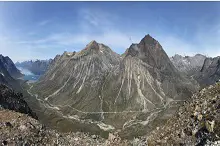Nalunaq hosts orogenic gold, predominantly in a quartz vein that averages 0.7 m wide (the ‘Main Vein’) within a highly continuous shear structure in Palaeoproterozoic metavolcanic rocks, part of the Ketilidian Mobile Belt. The Main Vein is a classic example of its type: grade distribution is very erratic, the gold is coarse and free, and resource estimation challenging; grades can be extreme: 5,240 g/t gold has been reported. Due to this extreme nugget, an approach of drilling for known structure first, with grade second, was employed.
Underground mining, using longhole open-stoping methods, took place between 2004 and 2013, first by Crew Gold and later by Angel Mining PLC, who installed a CIP plant within the mine. By the end, about 367,000 oz of gold is estimated to have been recovered from 700,000 t of ore. Mining ceased, the site was remediated and closed in 2014, leaving a common perception that the deposit had been exhausted.
Arctic-Resources (now Alopex Gold Inc.), supported by SRK ES, challenged this view and acquired the mining licence in 2015. SRK ES’ task was to make the case for Nalunaq’s exploration potential, and testing ideas in the field.
An SRK ES team of Geologists, Mining Engineers and Geotechnical Engineers moved on site during the 2015 and 2016 field seasons, approaching the project from all angles. Underground conditions and infrastructure were assessed, along with a study of the pillars, remnants and sweepings that remain. The relationship between grade continuity in the Main Vein and faulting was closely examined. Metallurgical check sampling was also conducted. On the surface, a team of specialist mountaineers assessed the upper parts of the mountain.
The surface sampling produced exciting results, confirming that the Main Vein structure is still mineralised all the way up-dip and across the mountain. Underground findings were equally significant, especially discovering frequent structural offsets to the Main Vein resulting in ‘lost’ reefs, challenging the historical concept of parallel ore shoots. Based on these results, it is now believed that this is a substantial exploration target ready for further investigation.
SRK ES was instrumental in realising the ongoing potential at Nalunaq and we are well positioned in researching and developing the wider South Greenland gold province.

